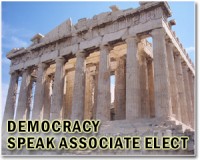| . |  |
. |
Cairo (UPI) Feb 15, 2011 Washington's role in arming Egypt and bolstering its defense industry over the last three decades was a key factor in defining how the country's military handled the ousting of President Hosni Mubarak earlier this month. Egypt's arms industry is the oldest, the largest and the most technologically advanced in the Arab world. The country's extensive military establishment, which has vast economic holdings, is funded to a large extent by $1.3 billion a year in U.S. military aid. So the generals who are in power in Cairo until a new government can be formed are likely to ensure they keep the Americans sweet by toeing Washington's line. The fact that Egypt's armed forces -- with 500,000 personnel in uniform and about the same number in reserves -- are equipped with U.S. weapons systems gives Washington significant leverage over the military and other important institutions. This was undoubtedly in play in recent weeks. "We've got a very strong relationship with the Egyptian military," U.S. Navy Adm. Mike Mullen, chairman of the U.S. Joint Chiefs of Staff, declared Monday during a visit to the Middle East. "We continue to stay in very close touch with our counterparts in the Egyptian military I think they've handled this situation exceptionally well." Egypt's military leaders have assured Israel that their landmark March 1979 peace treaty will remain intact despite the political upheaval and the downfall of Mubarak, who had assiduously maintained the treaty throughout his 30-year rule despite domestic opposition to it. The treaty is a cornerstone of U.S. strategy in the Middle East, particularly so in the current wave of political unrest sweeping the Arab world. Since the treaty was signed at Camp David in the United States, Egypt has received nearly $36 billion in military aid, making Egypt the second largest recipient of such aid after Israel. Jane's Information Group says U.S. aid totals about one-third of Egypt's defense budget of some $5 billion, although others estimate it is four or five times higher. The generals in Cairo would be loath to see that aid flow dry up. So would the U.S. defense sector, which in these days of economic cutbacks depends on foreign sales to maintain production lines and develop new systems. The U.S. funds must be spent on U.S. equipment and services and thus become effectively a subsidy for U.S. contractors. Lockheed Martin, Boeing, General Electric, Raytheon, General Dynamics and BAE Systems all do big business with Cairo selling fighter jets, tanks, radars, artillery and other hardware to Egypt. In 2010, Lockheed was paid $213 million for a new batch of 20 F-16s for the Egyptian air force, which has some 180 of the U.S.-built fighters. That makes Egypt the fourth largest F-16 operator. Lockheed Martin has made an estimated $3.8 billion from F-16 and other sales to Egypt. Boeing, which sells Cairo CH-47 Chinook transport helicopters, has earned an estimated $1.7 billion. General Dynamics Land Systems has banked some $2.5 billion by licensing the manufacture of M1A1 Abrams main battle tanks in Egypt. Jane's says Egypt's defense industry is "indirectly buoyed by U.S. funding." The origins of Egypt's military industry goes back as far as the 1820s, when the ruler of the day, Mohammed Ali, first established a number of factories to manufacture small arms, artillery, ammunition and warships. Then it went into a long decline, before being revived in the 1960s under Gamal Abdel Nasser who launched ambitious, but ultimately unsuccessful, programs to build bomber aircraft and long-range missiles helped by German scientists who built Adolf Hitler's V1 and V2 rockets. In April 1975, the Egyptians established the Arab Organization of Industrialization with other Arab states to produce weapons and other military equipment. That enterprise was short-lived but it boosted Egypt's drive to build its own military equipment. In the wake of the 1973 war with Israel, the Cairo regime expanded the industry. When Egypt booted out the Soviets in the early 1970s and moved toward the Americans, the industry took off, building U.S. weapons under license and exporting to regional states. More than 1,000 Abrams tanks have been produced at factories in the Cairo suburbs. Other state-owned enterprises, controlled by the Armament Authority and the National Organization of Military Production, manufacture light weapons and ammunition of all calibers, artillery, missiles and communications equipment.
Share This Article With Planet Earth
Related Links Democracy in the 21st century at TerraDaily.com
 Outside View: Looking for a leader in CPAC
Outside View: Looking for a leader in CPACWashington (UPI) Feb 14, 2011 Since 1975, when a former California governor named Ronald Reagan attended the Conservative Political Action Conference to argue that the movement needed to speak in "bold colors rather than pale pastels," CPAC has been a must stop for most anyone who wanted to be president of the United States. The cattle call of potential presidential candidates generally - George W. Bush being the n ... read more |
|
| The content herein, unless otherwise known to be public domain, are Copyright 1995-2010 - SpaceDaily. AFP and UPI Wire Stories are copyright Agence France-Presse and United Press International. ESA Portal Reports are copyright European Space Agency. All NASA sourced material is public domain. Additional copyrights may apply in whole or part to other bona fide parties. Advertising does not imply endorsement,agreement or approval of any opinions, statements or information provided by SpaceDaily on any Web page published or hosted by SpaceDaily. Privacy Statement |